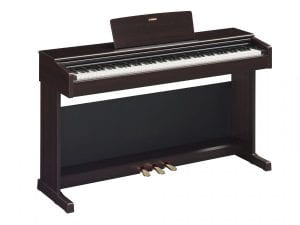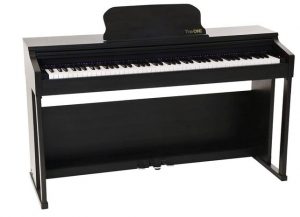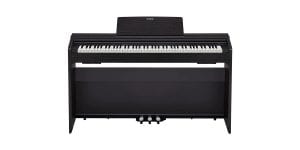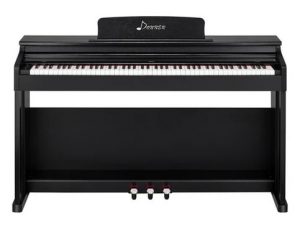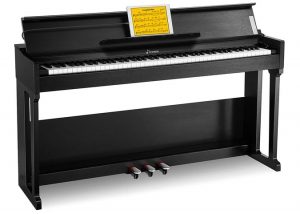Buying and maintaining an acoustic piano at home is not everyone’s piece of cake as they are costly and demand a lot of space. But there are many digital variations of these grand pianos available for beginners that are affordable, portable, compact, and easy to set up at home. They mimic the grand pianos in their sound quality and are their miniature versions, helping people in their music journey. We have picked the best upright pianos for beginners from the leading brands here to help you choose your best piano before starting your musical journey.
What Are the Best Upright Piano for Beginners?
Advantages of Upright Pianos
The conventional belief among many piano owners is that grand pianos are best and that an upright piano is more of a necessity than a preferred option. The distinctive qualities of upright pianos, which prompt some music enthusiasts to constantly pursue them out for their homes, are overlooked by this line of reasoning. Compared to grand pianos, upright pianos give interior designers a lot more flexibility when it comes to how the instrument should interact with the room. The choice of a larger piano with elaborate cabinetry makes the instrument a statement and draws attention to its beauty, whereas the choice of a smaller piano enables the piano to play a more subdued role in the interior design of the space. Upright pianos are frequently actively preferred by beginning pianists over grand pianos because they are smaller and less frightening. For beginning performers, especially children, who might find a grand piano extremely overwhelming, the size of an upright piano is far less intimidating. Before attempting to acquire the nuance or precision of a grand piano’s larger keys, a beginner can learn the fundamental feel and fondling of the instrument on an upright. The cheaper price of the upright is only an added benefit.
The upright piano’s built-in music stand, ornamental and more visually pleasing appearance, and the ability to open and close the keyboard lid to protect the keys are additional benefits.
- Weighted Hammer Action: The “genuine piano action” of the synthetic keys is highlighted and advertised by many digital pianos. The quality of digital pianos today is remarkably similar, but the more one plays the instrument, the more one can tell the difference. It involves more than just the weight of the keys because internal action also affects how the note is released and how it sounds. Moving to an upright piano is far more fulfilling for those who have performed extensively on a digital keyboard because there are numerous technical skills that are simply more difficult or impossible on the key action of a digital piano.
- Greater Sensitivity to Touch: There are more colours and tones to choose from on an upright piano because it contains all the internal working parts that combine to produce the sound. On a keyboard, there is a much smaller dynamic and articulation range than of an upright piano, and the delicacy of the physical keys on an upright allows even a rookie pianist to make and perceive sound variations. Being able to hear the differences as a student is crucial for your practice and development as a musician because listening to oneself is a crucial component of learning. On a digital piano, the notes’ actual sustain is also brief, making it impossible to use articulation methods like legato (or simply straightforward long notes and ties).
- Pedalling: The pedal is the “essence of the piano,” according to the renowned concert pianist and composer Anton Rubinstein. Without it, try learning the piano! The pedalling on a digital piano, particularly those of an entry-level beginner keyboard, is seldom able to catch the persistence of the notes and therefore is actually a disadvantage to novice pianists whose pieces need the use of pedal.
Performance of Upright Piano vs. Performance of Keyboard
Strings on an upright piano are arranged vertically. In comparison to the grand piano, it is much smaller. The upright piano is a more practical option because it frequently fits nicely in homes or apartments. Your fingers are reset by a spring mechanism, which is prone to wear and tear, when you remove your grip on the keys. The extent to which an overtone sounds higher in pitch than its fundamental pitch is known as inharmonicity. Therefore, a sound with less inharmonicity is more accurate. Longer strings on the grand piano give it a fuller tone as well as fewer inharmonicity. The shorter strings of the upright piano cause more inharmonicity, which results in less in tune octaves. Contrary to popular belief, the upright piano is not inferior. The caliber of the materials used and the craftsmanship, among many other factors, can also affect the sound. The instrument’s sound should be taken into account as one of the crucial elements. It should come as no surprise that the upright piano sounds better. As was previously indicated, when the hammer strikes a string, a sound is produced. You get an organic, acoustic sound from it that is warmer and more resonant in tone. Additionally, you have more control over the musical notes’ expressiveness and articulation. On the other hand, a keyboard can only imitate the sound of an acoustic piano. Since the sound is a digital file, the same acoustic nuances are not possible. However, a high-end digital piano may have a superior sound to a low-end acoustic piano. Because digital pianos lack touch sensation, some pianists avoid them. The acoustic piano responds to touch better. The tone of the sound is determined by the force and motion of your fingers, and you can create many tones on the same key. There is a limited number of tones that can be produced on the digital piano because the sounds are digital. In other words, the sound can be the same even if you played a key differently. The expression of your song may also be impacted by this restriction.
Three pedals are included with an acoustic piano: the soft pedal, sostenuto pedal, and sustain pedal. (The sustain pedal is regularly employed in all musical genres; the soft and sostenuto pedals are less common.) But some digital pianos—particularly portable digital pianos—only come with a sustain pedal, while others don’t have any at all. Naturally, a sustain pedal may be bought separately, but the sostenuto and soft pedals aren’t often offered as add-on accessories. Determining if the pedals’ presence would alter the playing experience is therefore essential. The richness of sound that an acoustic piano can provide simply cannot be reproduced by most electronic options, especially if a really high-quality keyboard is a little outside of the budget. I don’t want to focus too much on the sound scientific foundation of it all. But the explanation is as follows: There are other sounds that can be heard in addition to the fundamental sound that is produced when a key is struck on an acoustic piano. The “basic” sound is combined with other sounds called “overtones” or “partials” to form the distinctively complex sound that is produced by acoustic instruments. Like the voice, all acoustic instruments function in a similar manner. Electric keyboards typically lack the programming necessary to accurately reproduce that sound. Simply said, something doesn’t feel right.
Pros And Cons Of Console Pianos
A console piano is a sizable upright piano; however, unlike a grand piano, it does not have a horizontally positioned hammer on string action. The majority of console pianos are between 40- and 44-inches height, which keeps them small and space-saving yet gives them a greater sound and quality than spinets and other smaller upright pianos. Due to the vertical strings used in their construction, upright pianos are far more compact, thin, and portable than grand pianos. But more than simply the appearance has changed. Additionally, a console has a more direct action than smaller vertical pianos but a sound that is not as remarkable as bigger upright pianos or grand pianos. In contrast, an upright piano will have a more rich tone, resonant, and powerful sound.
Console pianos have the unusual advantage of blending in seamlessly with any setting. Because the piano’s amplifying soundboard has fewer square inches of resonating surface area, they are not overly loud or perceived as powerful. They are the cheapest pianos because they fall under the smallest size group. The more the piano must be strengthened to withstand heavy string tension, the taller it is, and generally, the more expensive it is. There is no doubt that console piano is a fantastic option for amateurs, beginners, and fitting into small parts. The console size is frequently seen as a far better alternative to a digital piano because it can have a similar footprint in the room while musically outperforming anything electronic.
Are console pianos flawed in any way? Console pianos are suitable when looking for a piano for someone who works in education for a while, but as the music demands more, professional-level pianos are typically favoured in terms of touch and tone response.
Also check: Best Beginner Digital Pianos & Keyboards 2024
5 Best Upright Pianos for Beginners
The following are the top five smaller, lighter and cheaper versions of the grand pianos and are great for beginners to enhance their finger technique and begin their piano-playing journey.
#1. Yamaha YDP-144 Arius Series Piano – Editor’s Pick
Check Price on Online Stores:
This is an exceptional piano series from the legendary Yamaha brand and it comprises of dark rosewood finish. The product comes with one YDP-144 model, bench, classical music masterpieces book, owner’s manual, and quick operations guide. This piano weighs about 8883 lbs. and has three pedals. The maximum number of polyphony in this piano is about 192 and it has ten voices and two standard stereo phone jacks, with standard recording and playback capabilities.
Its GHS weighted hammer action key bed is heavier in the low keys and lighter in the high keys, similar to an acoustic piano. The half-damper pedals in this piano help the pianist to constantly increase the amount of sustain as the pedals are depressed.
The CFX premium grand piano voice helps in recreating the tone and the power of the CFX concert grand piano, from the legendary Yamaha brand.
The piano keys have special matte black key tops and they are great in absorbing moisture from the keys and leaving them tactile, even after extended use, without getting slippery.
The Arius series of pianos from the Yamaha brand has graceful curves and a stylish design to make it a desirable piano of all times. It is also compatible with smart devices and helps us to simply connect the smart device by USB or through the Smart Pianist app.
Pros
- The piano recreates the iconic Yamaha CFX sound
- Its weighted keys help reproduce the controlled and responsive touch of a grand acoustic piano.
- The piano is compatible with the Smart Pianist or the Digital piano controller apps.
- There are three pedals in this piano to render the essential control and feeling on this piano.
Cons
- The sound quality is good, but it is not like a grand acoustic piano.
Note: This piano is also featured in our lists of best digital pianos for composing and best digital pianos under $1500.
#2. The ONE Smart Digital Piano – Best Quality for Beginners
Check Price on Online Stores:
This is an exceptional piano with 88-keys, grand graded hammer action keys, and an upright shape with a matte black finish. This is an exceptional piano from the One Music group and is guided by LED lights to start playing the instrument in minutes. The piano comes with more than 4000+ sheet music, 100+ videos, and games in the free apps. It supports both iOS and Android devices, in both phone and tablet mode.
This is an exceptional high-grade piano that has 88-weighted keys, professional stereo sound, three piano pedals, and a classic wooden body. The piano also features MIDI output and recording features and is made for beginners and is also loved by teachers and musicians. The piano has 88 keys with fully-weighted graded hammer action and has a maximum of 128-note polyphony. The piano has 166-bit stereo sampling tones and 128 GM-programmed timbres and four drum sets.
The piano is blended with all the technical controls through the app. Its practical features include a metronome, one volume control, two built-in 25W amplifiers, and two headphone sockets. There is a set of 88 red and blue LED lights on this piano and these lights above the piano keys light up the show and works with the app. The LED lights will light up to show which key to press and will wait until the player hits the right notes, before moving on to the next key.
Pros
- This premium piano integrates smart learning with an elegant appearance, along with hammer action keys and outstanding acoustic performance.
- The piano is blended with full technical controls and is compatible with the app.
- The ONE smart piano has three pedals at the base of the piano to give a complete range of control on the sound of the instrument.
- The piano has two built-in 25W amplifiers and two headphone sockets.
Cons
- It doesn’t come with a user manual
- The piano is quite heavy and requires assistance for assembling.
#3. Casio Privia PX-870 Digital Piano – Popular Among Beginners
Check Price on Online Stores:
This is a great digital piano that comes with more than 19 instrument sounds, along with the ability to layer and split the piano tones as required. The piano has a great touch response, three sensitivity levels, along an Off feature. The piano has generous 256 notes of polyphony that help us make even the complex music performances sound perfectly natural. The tri-sensor scaled hammer action keyboard of this piano offers an incredible feel and captures the dynamics of music performances with unparalleled accuracy and speed.
This digital piano features a powerful 40-watt four-speaker system and it is designed to envelop the entire room with rich, detailed, and high-quality sound. Its volume Sync EQQ feature ensures that the audience hears a clear and balanced sound, across the entire frequency range, at the best listening volume. Its USB connectivity feature in this piano allows the instrument to be used either with Windows or Mac computer, without having to download the drivers.
The piano has an AiR sound engine that recreates highly accurate grand piano sounds with seamless dynamics for a remarkably expressive and powerful performance. This is a new flagship piano model from the world-renowned Privia line of digital pianos and it is designed to offer a true piano experience. This is a revolutionary piano brand that features a stylish slimline design and a dynamic new sound projection speaker system.
Pros
- This is an ultimate Casio Privia digital piano that is suitable for all piano players.
- Its new AiR sound source includes a damper and action noise feature with tri-sensor II hammer action keys.
- Its hall simulator feature uses real acoustic measurement to recreate the ambiance of famous concert halls.
- The piano is compatible with Android and iOS devices and the Chordana app to play in a fun way.
Cons
- This piano is not portable and is heavy.
- The stand is made of pressed wood with a plastic foot pedal bar.
Note: This piano is also featured in our lists of best home digital pianos and best digital pianos for classical pianists.
#4. Donner DDP-100 Digital Piano – Quality Budget Pick
Check Price on Online Stores:
Donner is a pioneer in manufacturing high-order digital piano keyboards, to enhance the joy of the piano playing experience for all people. The Donner DDP-100 is intended in creating high-quality piano music with its three-dimensional soundscape and a full range of tones. It is also made of high-quality wood and is intended to create innovative and excellent music instruments for professional music artists and creators.
This is an exceptional digital upright piano for beginners with a furniture stand, triple pedals, power adapter, and MP3 function, and is available in rich black colors. The piano has 88-keys fully weighted digital keys that precisely match the changes in the finger strength. Its fully weighted hammer action key bed helps in restoring the true piano finger strength stably. The sounds from this piano feel excellent and realistic and help the pianist in developing a keen ability in distinguishing clear piano sounds.
The piano has a built-in MP3 function and built-in amplifiers, that supports external sounds and headphone to meet the needs of diverse occasions. The Donner digital piano has a streamlined design, wooden cabinet, and a sliding key cover to help protect the keys. The piano has a 128-note polyphony and features pure tones that are sampled from real acoustic grand pianos, which helps in guaranteeing the quality of the performance and piano practice.
Pros
- The full-size hammer-weighted keys of this piano help in restoring the real function of a digital piano.
- It features a three-pedal function for clear tones and damper effects
- Its AWM dynamic sampling technology helps create deeper, broader, and richer sounds.
Cons
- The speakers are not great in sound clarity
- Tough to locate the headphone jack.
Note: This piano is also featured in our list of best digital pianos under $700.
#5. Donner DDP-90 Digital Piano – Suits All Skill Levels
Check Price on Online Stores:
This is a great digital piano that comes with an 88-key weighted piano keyboard for professional and beginner pianists with adjustable touch response. The piano keys precisely match the finger strength changes, which is great for early finger development for beginner pianists. There is also an excellent flip cover with a slow closing function to protect both the hands and the keyboard. The piano comes with three pedals and supports connectivity with tablets, cell phones, and personal computers.
This digital piano from Donner comes with 128 polyphonies to create intricate piano tunes instantly from the comforts of one’s living room. This electric piano always plays in tune and it thus helps beginners acquire and maintain absolute pitch. It is compatible with multiple devices and comes with U-disk MP3 playing functionality. It also has a built-in amplifier and is compatible with laptops, tablets, PC, and smartphones.
It features an external sound support system and connects with a headphone jack that is present at the bottom left of the piano. It also has an audio in and out feature and features high-quality sound samples for real acoustic grand pianos. Thus, this is a great piano for practicing in both home, concerts, and stage shows.
Pros
- This is a beautiful and practical digital piano.
- Its AWM sampling techniques help with realistic sounds and a perfect piano playing experience.
- The piano is compatible with the Donner music app with a wealth of music lessons for the pianist.
Cons
- There are no built-in speakers and require connection with external speakers.
Note: This piano is also featured in our list of best digital pianos under $1000.
What To Look For In Your Beginner’s Upright Piano?
The aspects that you should look for in the piano depend largely on the age of the pianist. Small children when they start their piano journey start with electronic keyboards and as they master the technique, they can purchase the beginner’s piano, that mimics the grand pianos. After deciding to invest in a piano, inspect the instrument for the following features.
1. The key-bed of the piano
The beginner’s piano could either have a 61-key set or an 88-key bed. It is better to opt for pianos that have 88 keys with graded hammer action so that they will be able to replicate the true sounds of the grand acoustic piano. The keys should be touch-sensitive and have a matte finish to prevent slipping of fingers.
2. Sounds other than piano sounds
If you are looking to buy a great digital piano, it must have a realistic acoustic piano tone. Apart from the piano tunes, the keyboard will also have other voices, synths, and instrument sounds, that will be both fun and help in learning the piano playing technique.
3. Piano pedals
A host of beginner’s pianos comes with piano pedals and the sustain pedal is important to create and play the damper sounds for great music creation. Most of the pianos that we have listed here come with damper pedals for great piano action.
4. Headphone compatibility
This is seen as an important feature in beginner’s pianos as it helps them to practice without disturbing others and listen to their music to correct themselves.
5. Music apps
Ensure that the piano you buy is compatible with music apps and can be connected with laptops, computers, and other smart devices to help learn new songs and piano techniques. Make sure the piano that you opt for, has several other keyboard modes such as duo, dual, and split so that both the student and teacher can play and practice together on the same instrument.
You Might Also Like
- Best Synthesizer Sequential Prophet 6
- Top Trending Komplete Kontrol S49 MK2 Keyboard
- Best Roland JUNO DS 88-Key Digital Piano
- Best Digital Piano Yamaha P71
Final Words
A good piano is ideal to embark on the musical journey of students and it should help them to enhance their musical skills. We hope our buying guide and our product recommendation help you in picking up one of the best upright pianos for beginners.
Frequently Asked Questions (FAQs)
1. How does the level of proficiency influence your buying decisions?
For novices, especially self-taught pianists, a digital piano might be preferable. A computer and your digital piano can be connected to provide a wealth of educational opportunities. However, playing upright pianos calls for some level of experience.
2. How does a console piano work?
Console pianos differ from spinet pianos in that its usual action simply rests on top of the keys, with the hammers sitting upright rather than in a lowered posture. As a result, the hammer is dragged back into place when the strings are struck by the hammers and the key is released.
3. What is a console piano used for?
A console piano is an upright piano that is bigger. Like other smaller upright pianos, it is still small and saves room, but the sound quality is unaffected. The console piano has a fantastic quality of sound that is considerably greater than a spinet, but it isn’t as resonant or rich as just a grand piano, making it ideal for advanced piano players and home pianists.
4. Which should one choose? Upright piano or console piano?
A console piano is a smaller-sized vertical piano with a good, bright sound and tone appropriate for home pianists, but an upright piano will be the finest option for a very versatile and impressive house piano, suitable for beginner pianists and advanced, professional pianists.
5. Is the keyboard preferred over pianos?
The flexibility of the keyboard is superior to that of the piano in terms of functionality. Pianos have only one sound. Although they produce it in a variety of dynamics and tones, it still has a single overall sound. On the other hand, keyboards can have their sound customised to suit a wide range of musical requirements.
6. What is the con of an electronic keyboard?
The electric keyboard’s dependence on power or batteries to function is undoubtedly a drawback. That is obviously not a problem for an acoustic substitute. But it shouldn’t be too much of a problem unless you are having trouble coming up with things to do in the event of a power outage.


